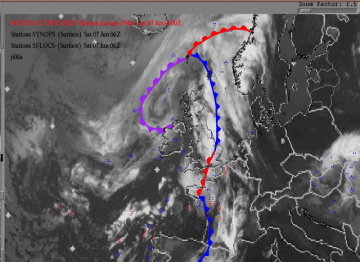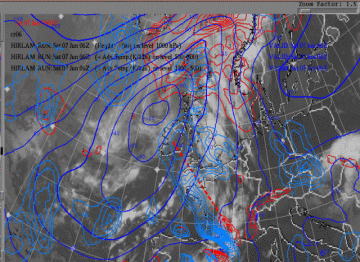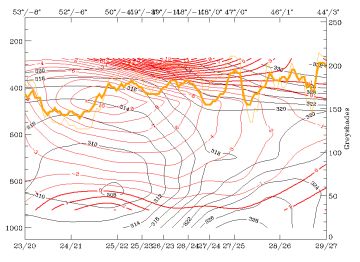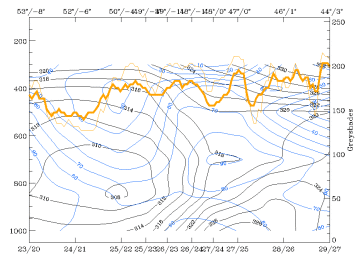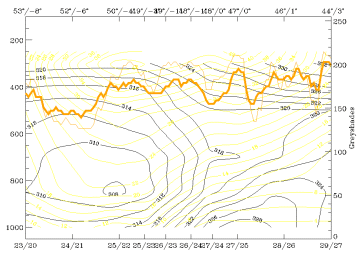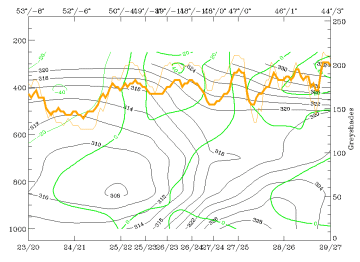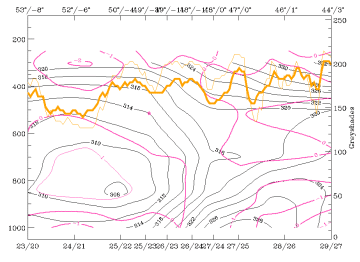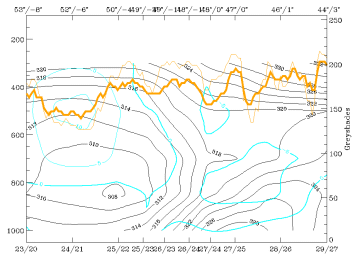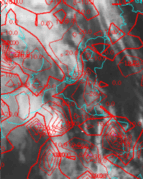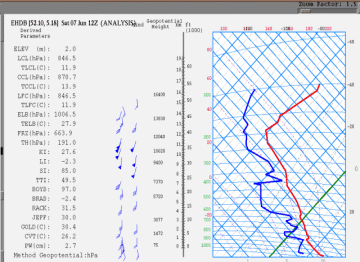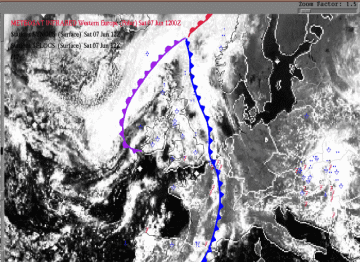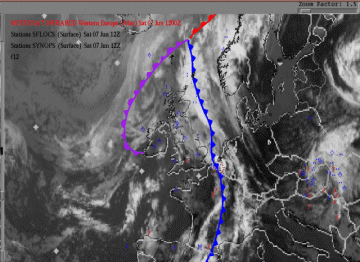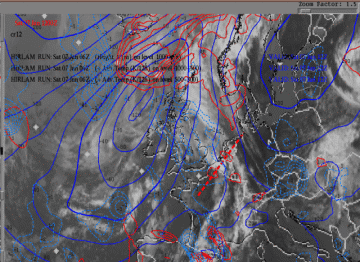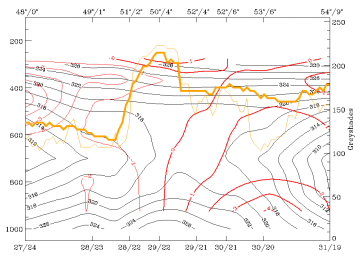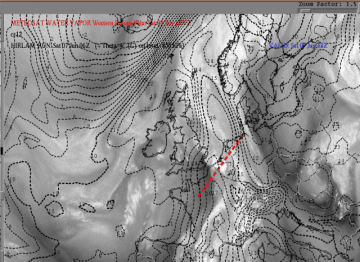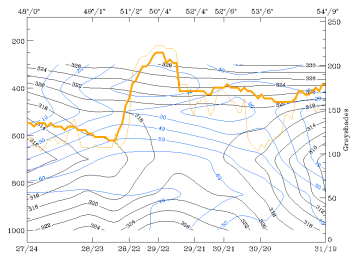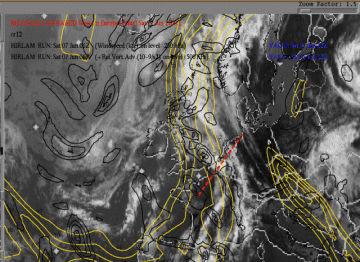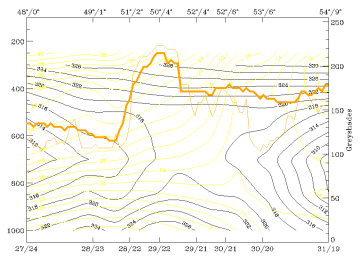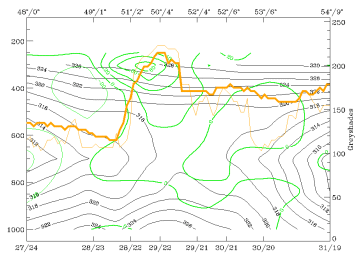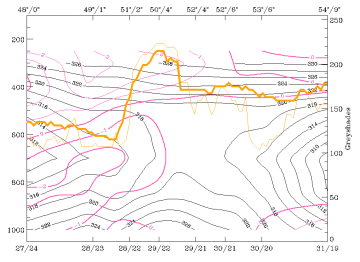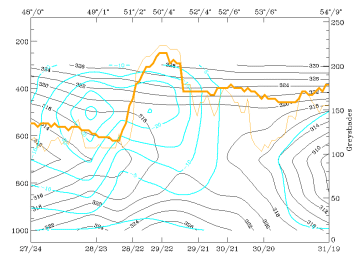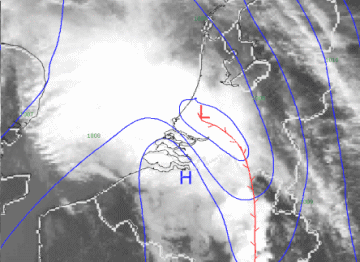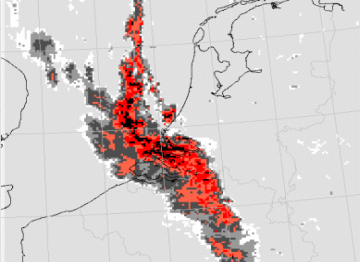Table of Contents
07 June 1997 - Diagnosis For 07 June 06.00 UTC
|
07 June 1997/06.00 UTC - Meteosat IR image; weather events (blue: WW code, red: SFLOCS)
|
|
This satellite image contains the cloud configuration of a frontal system over the western part of Europe connected with a depression with its centre north-west of Ireland. The cloud band over east Britain and western France belongs to a slow eastward moving Cold Front (compare Conceptual Models: Cold Front ).
Over the entrance to the English Channel, approximately 49N/05W, an area of enhanced cloudiness is to be seen. In this area a weak Wave in the Cold Front is present (compare Conceptual Models: Wave ). The cloud band of the Cold Front is very distinct in its northern part. Just east of the Cold Front a small surface trough was detected in the isobars.
Within the surface trough and in the Cold Front thunderstorm activity was observed.
Very close to the surface front, approximately 48N/00E, a cloud cluster with cold tops can be detected in which also thunderstorm activity was reported.
For the diagnosis of the physical state of the conceptual model Mesoscale Convective System a couple of key parameter and useful key parameters combinations are available which were chosen with respect to the conceptual model (for more information see Conceptual Models: Cumulonimbus (Cb) and Mesoscale Convective System (MCS) ).
This combination is indicative of growing instability in the troposphere.
- The height contours very close to the ground, 1000 hPa (gpm), which in the case of convective clusters often show a trough in front of the Cold Front.
- In the case of convective clusters, advection of warm air in the lower layers causes growing instability.
- Advection of cold air in the upper layers can also be the source of growing instability.
|
07 June 1997/06.00 UTC - Meteosat IR image; cyan: height contours 1000 hPa, red: temperature advection - WA 1000 hPa, blue:temperature
advection - CA 500hPa; position of vertical cross section indicated
|
07 June 1997/06.00 UTC - Vertical cross section; black: isentropes (ThetaE), red thin: temperature advection - CA, red thick:
temperature advection - WA, orange thin: IR pixel values, orange thick: WV pixel values
|
The parameter combination in the IR image above indicates cold advection in the upper layers in and behind the cloud configuration of the Cold Front. Significant warm advection in the lower layers is only to be seen over southern France and Spain. The cloud cluster 48N/00E is near, but not in the advection area. The cross section shows weak WA in the lowest layers, below 900 hPa near the cloud cluster and weak CA above. In the area of the investigated cloud cluster decreasing Theta values with height are detectable, indicating high instability. The maximum of WA in the lower levels and cold advection above are to be found in the area of the weak Wave in the Cold Front (49N/05W). The Cold Front feature is to be seen in the Theta values above the 850 hPa level in the north-western part of the cross section.
Thickness 1000/500/ThetaW 850 hPa + WV + Vertical Cross Section with relative humidity
In the case of mesoscale convective systems the sensitive area is within the thickness ridges and in a very distinct ThetaW 850 hPa ridge with relatively high values. In most of the cases the pattern of the ThetaW ridge shows great similarity with the thickness ridge. In addition the values of ThetaW 850 hPa give an indication of the amount of potential energy and moisture. The water vapour image gives an indication for moist air at higher levels. Dark grey in the WV images indicates dry air in the middle and higher troposphere. This information can be of great importance in cases of potential instability.
The cross section indicates the distribution of humidity in the vertical.
|
07 June 1997/06.00 UTC - Meteosat WV image; black: wet bulb temperature 850 hPa; position of vertical cross section indicated
|
07 June 1997/06.00 UTC - Vertical cross section; black: isentropes (ThetaE), blue: relative humidity, orange thin: IR pixel values,
orange thick: WV pixel values
|
The cloud cluster at 48N/00E is very close to the ThetaW 850 hPa ridge and in the area where high WV pixel values (moist air in the middle and upper troposphere) are changing into low WV pixel values (dry air in the middle and upper troposphere). Striking are the high values of ThetaW over southern France and the Netherlands.
In the cross section high humidity values extend to the mid-troposphere within the cloud cluster, but to the north-west and south-east of the cluster the air is moist in the lower levels but relatively dry in the higher parts.
Isotachs 250 hPa >= 60kt + PVA500 >= 2 + IR + Vertical Cross Section
This combination is indicative of dynamical forcing due to the influence of a jet streak.
- The isotachs give an indication of the position of the jet streak and the position of the maximum horizontal shear.
- The vertical cross section shows the vertical wind shear which is important for the development of strong Cb clusters.
- PVA500>=2: this parameter shows maxima of positive vorticity advection (PVA) at 500 hPa exceeding 2 units # (*10-9sec-2); this key parameter indicates areas with increased vertical motion.
|
07 June 1997/06.00 UTC - Meteosat IR image; black: positive vorticity advection (PVA) 500 hPa, yellow: isotachs 250 hPa; position of
vertical cross section indicated
|
07 June 1997/06.00 UTC - Vertical cross section; black: isentropes (ThetaE), yellow: isotachs, orange thin: IR pixel values, orange
thick: WV pixel values
|
|
07 June 1997/06.00 UTC - Vertical cross section; black: isentropes (ThetaE), green thick: vorticity advection - PVA, green thin:
vorticity advection - NVA, orange thin: IR pixel values, orange thick: WV pixel values
|
|
The cloud cluster over the entrance to the English Channel is within the PVA zone at the left exit of a 250 hPa jet streak. The investigated cloud cluster at 48N/00E is near, but not in, a 500 hPa PVA maximum. In the cross section the PVA maximum is just north-west of the cluster 48N/00E. PVA seems not to have much influence on the development of the cluster in this stage of development.
The cross section of the isotachs indicates a positive wind shear in the vertical in the area of the investigated cluster. Positive wind shear is a clear indication that up- and downdrafts in the single Cb cells will be separated. This phenomena will lengthen the life cycle of the Cbs substantially.
Divergence and vertical motion
This combination indicates the role of divergence in the total vertical motion (omega).
This combination is best shown with vertical cross sections because the height of the maxima and minima of divergence and omega can vary much from case to case.
- The omega parameter indicates the vertical motion as a result of differential temperature advection, vorticity advection or from diabatic heating.
- Divergence indicates the dynamical forcing by PVA or by friction effects.
|
07 June 1997/06.00 UTC - Vertical cross section; black: isentropes (ThetaE), magenta thin: divergence, magenta thick: convergence,
orange thin: IR pixel values, orange thick: WV pixel values
|
07 June 1997/06.00 UTC - Vertical cross section; black: isentropes (ThetaE), cyan thick: vertical motion (omega) - upward motion, cyan
thin: vertical motion (omega) - downward motion, orange thin: IR pixel values, orange thick: WV pixel values
|
The cross section gives no indication of strong vertical motion in the area of the investigated cluster. Some convergence in the boundary layer can be seen, but the negative omega values are very low. South-east of the clusters convergence and negative omega values are much more present.
Relative streams
This parameter shows relative streams on isentropic surfaces; relative streams are indicative of the different air masses involved in the process and of areas with sinking or rising air; they can be used to interpret cloud configurations requiring special explanation.
Although of much importance in a conceptual model of mesoscale convective clusters, the relative streams could not be calculated for this case study and are not further discussed here.
Summary of diagnosis 06.00 UTC
The investigated cloud cluster is within an area where dynamic forcing is present but not significant. Most of the features are situated just west of the cluster, or even east of it.
A larger area over France is within very unstable and, in the lower levels, very moist air, which is ideal for the development of thunderstorms. The vertical wind shear in the area of the cluster also play an important roll in the development.
The parameters and the combination of parameters used in this case indicate an ideal situation for the development of a Mesoscale Convective System. However, the area in which these clusters could develop was much larger than the cluster itself. Why the shower activity was enhanced in that particular small area is not clear from the model analysis. The low (for mesoscale developments) resolution of the models, combined with the fact that model analyses are a combination of guesswork and observations, could be the cause of this.
07 June 1997 - Forecast For 12.00 UTC And 18.00 UTC
|
07 June 1997/06.00 UTC - Meteosat IR image; yellow: positive vorticity advection (PVA) 500 hPa 06.00 UTC, green: positive vorticity
advection (PVA) 500 hPa 12.00 UTC, blue: positive vorticity advection (PVA) 500 hPa 18.00 UTC
|
|
At 12.00 UTC the PVA maximum in the investigated area has moved from Brittany towards the mouth of the river Thames, approximately a hundred kilometres west of the position of the actual MCS at 12.00 UTC. At 18.00 UTC PVA values were low in the area just north of the Netherlands, the position of the MCS at that time. The system was already in a decaying state by then.
07 June 1997 - Development Of The MCS Between 06.00 UTC And 12.00 UTC
Developments and movements of the most important cloud clusters shows best with deviation images. High pixel values (white) indicate movement or/and development of high clouds, while low pixel values (black) give an indication of decreasing cloudiness.
These deviation values can also be calculated. Positive values signify developing cloudiness, negative values dissolving cloudiness.
|
07 June 1997/08.00 - 09.00 UTC - Meteosat IR development image
|
07 June 1997/09.00 UTC - Meteosat IR image; red: mean values of grey shades of cloud development and decay
|
In the development image the white area just north of Paris indicates very strong developments in the cloud cluster which has moved steadily north-east in the period from 06.00 till 09.00 UTC. South-west of the area a black spot can be seen which indicates dissolving of the clouds. From the development values it can be seen that the maximum development of the cluster is at the north-eastern edge, while the maximum decay (negative values) is at the south-westerly side.
Radiosonde Soundings
Soundings from radiosondes are very helpful in detecting an unstable air mass. They have the advantage of giving a true picture of the state of the atmosphere, more than model fields can do. A disadvantage is the fact that they represent only a one dimensional state of the atmosphere. To make use of these soundings one has to assume that the data are representative of the whole air mass.
|
07 June 1997/12.00 UTC - Radiosounding De Bilt (06260)
|
|
The radiosonde was released at 11.00 UTC in the same air mass as that in which the investigated cloud cluster existed. Particularly striking are the high instability values from the different instability indices which are listed at the left side of the tephigram. For instance the Boyden index (boyd) and the Total totals index (TTI) show very high values indicating the possibilities of heavy and frequent thunderstorm activity. The air is very unstable below 200 hPa with the exception of two capping inversions at 900 and 630 hPa. These inversions were situated below potential unstable layers and could therefore easily disappear in the case of strong convection. A strong positive vertical windshear is shown with a general veering with height.
07 June 1997 - Diagnosis For 07 June 12.00 UTC
|
07 June 1997/12.00 UTC - Meteosat VIS image; weather events (blue: WW code, red: SFLOCS)
|
07 June 1997/12.00 UTC - Meteosat IR image; weather events (blue: WW code, red: SFLOCS)
|
The Cold Front still shows a wavy pattern. Just in front of the Cold Front over western Belgium and the south-west of the Netherlands, a cloud cluster is to be seen with high, cold tops. This convective cluster had meso beta dimensions at the time of the analysis (12.00 UTC). Heavy thunderstorm activity was reported with hail and gusts up to 70 kts.
ABSTOP1000 + WA1000-500 + CA 500-300 + IR + Vertical Cross Section
|
07 June 1997/12.00 UTC - Meteosat IR image; cyan: height contours 1000 hPa, red: temperature advection - WA 1000 hPa, blue:temperature
advection - CA 500hPa; position of vertical cross section indicated
|
07 June 1997/12.00 UTC - Vertical cross section; black: isentropes (ThetaE), red thin: temperature advection - CA, red thick:
temperature advection - WA, orange thin: IR pixel values, orange thick: WV pixel values
|
Warm advection in the lower levels and cold advection in the higher level are now clearly to be seen in the area of investigation (west Belgium - south-west Netherlands), although most of the cold advection in the higher levels is more in the western part of the area, as can be seen in the cross section.
ThetaW 850 hPa + WV + Vertical Cross Section with relative humidity
|
07 June 1997/12.00 UTC - Meteosat WV image; black: wet bulb temperature 850 hPa; position of vertical cross section indicated
|
07 June 1997/12.00 UTC - Vertical cross section; black: isentropes (ThetaE), blue: relative humidity, orange thin: IR pixel values,
orange thick: WV pixel values
|
The investigated cloud cluster is clearly within the ThetaW 850 hPa ridge with very high pixel values in the WV image (moist in the middle and/or higher levels). Behind the cluster low pixel values are to be seen indicating the presence of dry air in the higher levels.
Isotachs 250 hPa >= 60kt + PVA500 >= 2 + IR + Vertical Cross Section
|
07 June 1997/12.00 UTC - Meteosat IR image; black: positive vorticity advection (PVA) 500 hPa, yellow: isotachs 250 hPa; position of
vertical cross section indicated
|
07 June 1997/12.00 UTC - Vertical cross section; black: isentropes (ThetaE), yellow: isotachs, orange thin: IR pixel values, orange
thick: WV pixel values
|
|
|
|
|
07 June 1997/12.00 UTC - Vertical cross section; black: isentropes (ThetaE), green thick: vorticity advection - PVA, green thin:
vorticity advection - NVA, orange thin: IR pixel values, orange thick: WV pixel values
|
|
The cloud cluster over Belgium and the Netherlands is within or very close to a maximum of PVA 500 at the warm side of a jet stream in the vicinity of the right entrance of a jet streak over Scotland. The cross sections show very distinct features in the area of the cluster; the maximum of the PVA is at the 300 hPa level. In the cross section of the isotachs a strong positive vertical windshear is visible.
Divergence and vertical motion
|
07 June 1997/12.00 UTC - Vertical cross section; black: isentropes (ThetaE), magenta thin: divergence, magenta thick: convergence,
orange thin: IR pixel values, orange thick: WV pixel values
|
07 June 1997/12.00 UTC - Vertical cross section; black: isentropes (ThetaE), cyan thick: vertical motion (omega) - upward motion, cyan
thin: vertical motion (omega) - downward motion, orange thin: IR pixel values, orange thick: WV pixel values
|
The high positive and negative values of the divergence, and (as a consequence) the high values of negative omega in between, give a striking image of the ideal dynamic situation for an MCS.
Summary of diagnosis 12.00 UTC
The convective cluster over the southern Netherlands is now clearly under the influence of dynamic forcing. The temperature advection distribution, with warm advection in the lower layers and cold advection above, unstabilises the atmosphere. Strong convection is possible in such a situation.
Strong positive vorticity advection causes strong upward motion which intensifies the activity of the MCS.
07 June 1997 - Mature Stage Of The System
|
07 June 1997/13.00 UTC - NOAA HRPT image; blue: surface isobars, red: convergence line
|
07 June 1997/13.00 UTC - Radar image; red: precipitation rates
|
Around 13.00 UTC the system was most active with the heaviest storms in its central part west-south-west of the Netherlands. A squall line formed along the surface trough. In the northern part of the line heavy thunderstorms were reported with hail and damaging gusts up to 70 kts.
The original Cold Front has amalgamated with the thermal trough which was originally situated in front of it. Significant is the sharp ridge in the isobars at the rear of the squall line due to the outflow of cold air from the storm cells. In the north-western part of the system the outflow patterns are to be seen over the North Sea. They may be the result of a strong rising Warm Conveyor Belt over the original Cold Front. Relative streams can give more clarity about this feature.
After 13.00 UTC the activity of the system decreased although thunderstorms were still reported in the remnants of the cluster at 18.00 UTC.
07 June 1997 - Summary
This case study showed a classic situation for developing thunderstorms. The warm and moist layers in the lower parts of the atmosphere, together with the advection of warm air in these low levels, were ideal for the development of heavy showers. Also diurnal heating played an important role. At the first stage of this development no significant dynamical forcing was present. At a later stage however strong PVA and advection of cold air in the middle and higher levels intensified the development to a real MCS along a squall line.
